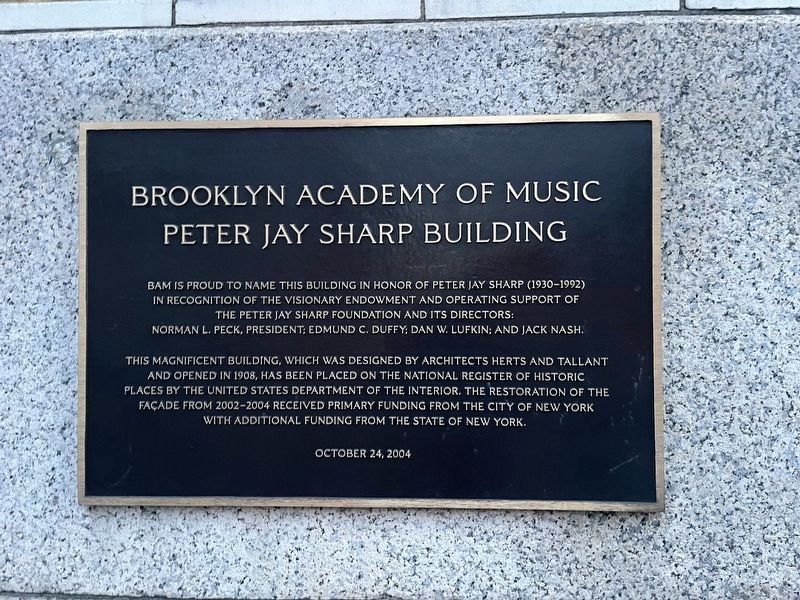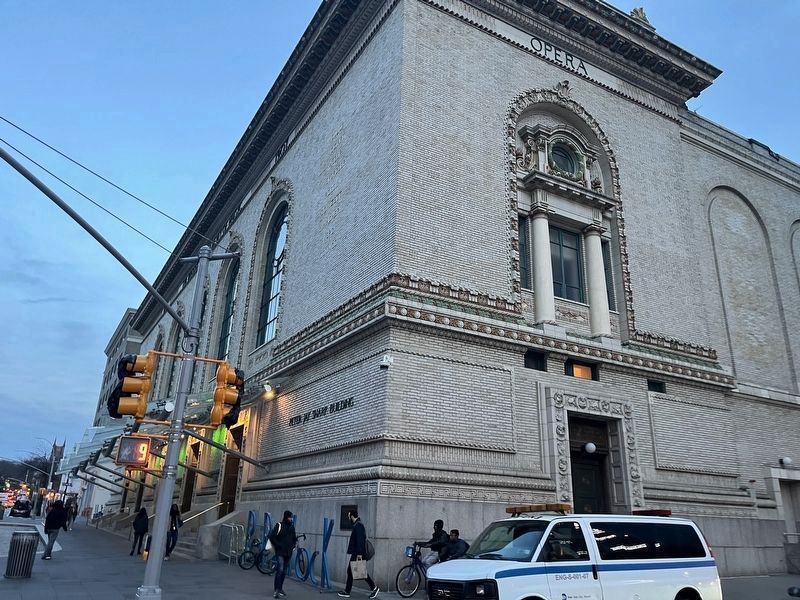Fort Greene in Brooklyn in Kings County, New York — The American Northeast (Mid-Atlantic)
Brooklyn Academy of Music
Peter Jay Sharp Building
BAM is proud to name this building in honor of Peter Jay Sharp (1930-1992) in recognition of the visionary endowment and operating support of the Peter Jay Sharp Foundation and its directors: Norman L. Peck, President; Edmund C. Duffy; Dan W Lufkin; and Jack Nash.
This magnificent building, which was designed by architects Herts and Tallant and opened in 1908, has been placed on the National Register of Historic Places by the United States Department of the Interior. The restoration of the façade from 2002-2004 received primary funding from the City of New York with additional funding from the State of New York.
Erected 2004 by Brooklyn Academy of Music.
Topics. This historical marker is listed in these topic lists: Architecture • Arts, Letters, Music • Education • Entertainment. A significant historical year for this entry is 1908.
Location. 40° 41.206′ N, 73° 58.684′ W. Marker is in Brooklyn, New York, in Kings County. It is in Fort Greene. Marker is on Lafayette Avenue. Touch for map. Marker is at or near this postal address: 6 Lafayette Ave, Brooklyn NY 11217, United States of America. Touch for directions.
Other nearby markers. At least 8 other markers are within walking distance of this marker. Did You Know? (a few steps from this marker); a different marker also named Did You Know? (within shouting distance of this marker); Betty Carter Park (about 300 feet away, measured in a direct line); a different marker also named Betty Carter Park (about 300 feet away); a different marker also named Did You Know? (about 300 feet away); Brooklyn Bronzes (about 400 feet away); a different marker also named Did You Know? (about 500 feet away); Fowler (about 600 feet away). Touch for a list and map of all markers in Brooklyn.
Also see . . . Brooklyn Academy of Music National Register of Historic Places Nomination Form.
This form was prepared in 2005 by Kathy Howe, Historic Preservation Specialist with the New York State Office of Parks, Recreation and Historic Preservation. A statement of the building's significance can be found on page 11:
The Brooklyn Academy of Music is a site of national significance under criterion C as one of the most complex and distinguished theater buildings in America with its large opera house, small music hall, expansive lobby, and series of smaller spaces all under the same roof and all sharing the same circulation system. The theater is a masterpiece designed by Herts & Tallant, the most prominent architecture firm involved in theater design in America during the early years of the twentieth century. In addition,(Submitted on March 11, 2024, by Devry Becker Jones of Washington, District of Columbia.)the building is nationally significant under criterion C for its pioneering use of polychromatic terra cotta on the street facades. The building is one of the earliest to display color on the facade and retains an extensive amount of important terracotta detail manufactured by the Atlantic Terra Cotta Company. The Brooklyn Academy of Music is also significant under criterion A in the area of social history as a manifestation of the growth of Brooklyn as a major urban center and a reflection of the pride that Brooklyn residents had in their community, even after the independent city became a borough of New York City. The building, planned for a variety of performance, social, political, and civic activities, was entirely paid for with donations from Brooklyn residents. The building was a major venue for cultural events, political events, and social events in the early decades of the twentieth century, hosting most of the leading figures of the era. In addition to its architectural significance and its significance in the history and development of Brooklyn, the Brooklyn Academy of Music is exceptionally significant in its more recent past for its association with the history of performing arts in the United States. Beginning in 1967, under the direction of Harvey Lichtenstein, the Brooklyn Academy of Music became a national and international leader in the presentation of contemporary and avant garde dance, music, and theater. By 1976, less than a decade into Lichtenstein’s long tenure, the Brooklyn Academy of Music was recognized as having a profound influence on American culture.
Credits. This page was last revised on March 11, 2024. It was originally submitted on March 11, 2024, by Devry Becker Jones of Washington, District of Columbia. This page has been viewed 44 times since then. Photos: 1, 2. submitted on March 11, 2024, by Devry Becker Jones of Washington, District of Columbia.

